H260
Rudder
Click any picture to expand
Overall
assessment of the rudder:
I'm pretty satisfied with the H260 rudder. Boat designers have to make many
compromises and the H260 rudder is one of them. There are significant
differences between the H26 and the H260 rudders. A review of comments in
sailboatowners.com indicates although very stout, there was dissatisfaction with
the H26 rudder because it is fairly heavy. Hunter designed the H260 rudder so that it was lighter and would float.
Both rudders have a foam core and are subject to the same problems.
Because the H260 rudder flexes, stress cracks appear on the aft edge. The
fiberglass shell
is thin and easily damaged. Water can infiltrate into the core due to the cracks
or when you drag it on the ramp, drop it, or hit a rock. This minor damage
is easily repaired with a little glass fiber and epoxy. Don't take this rudder
for granted -- inspect it frequently.
|
Click on any picture to
expand |
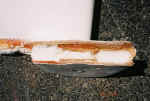 |
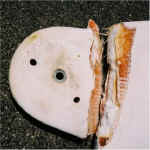 |
 |
| When damage to the skin occurs, water infiltrates
and weakens the foam core. |
This
rudder failed during an ugly jibe in very high winds. Other than a few skipped
heart beats and flapping sails, we slowly motored home with no problem. |
The rudder
flexes due to side stress; as a result, cracks develop along the aft edge of the
rudder. This is easy to repair. |
Considering the abuse
it gets, I think the rudder works well. Except in the case of a total failure, repairs
are fairly easy. Hunter was very responsive to my warranty requests for
replacement. but since the boat is now out of production, you will
pay about $600 or more for a replacement. Loss of a rudder can have a
variety of impacts -- from inconvenient to catastrophic. all sailors should be able to
sail with some degree of competence without a rudder. There is an excellent
article at this link.
Check out this alternative
Rudder
Craft (Formally IdaSailor Marine) makes a high density
poly blade machined from a solid blank of material. The replacement requires no
modification to your boat. Most buyers are enthusiastic about this blade, but it
is not indestructible. One owner has broken two; but he works his boat
hard with two trips to the Bahamas and the 5800 mi Great Loop under his belt. Check this
link for more on the catastrophic
failure of the Ida Sailor rudder. That said, the company has many satisfied
customers, the company
provides a lifetime warranty, and will respond with a overnight replacement if
necessary. There are at least two lengths for the H260 - the standard 55" length and a shorter 48" length. You can talk to the company about
the reasons why it offers these different sizes. I personally see
several advantages to this rudder. It is at least as strong as the Hunter/Foss Foam
rudder, won't crack and allow water to get into the core, and when you drag
it on the ramp or over a rock (and you will) it's a simple matter to sand the
scratches off.
A
spare is a good idea with any boat with a kick-up rudder. I
have a spare Hunter/Foss Foam rudder, and they are fairly easy to repair with a little
fiberglass material and epoxy, so I don't plan on replacing it with the poly
blade anytime soon, but would like to eventually. Ida Sailor Marine also sells
rudder shear pins made of the poly material. They come two to a bag, and last I
checked were $5.95
a bag. A bargain.
Doing
the "One - Footed Flamingo Tango"
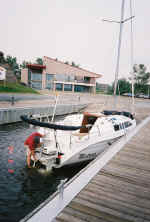 Because
Hunter designed the rudder with positive flotation, when you ground it, the pin
shears and the rudder readily pops to the surface. That's a good thing. Because
the stock rudder is very buoyant, getting it down takes practice and agility to
pin it. My original method was to balance on the step with the left foot, pull
down on the line with the left hand, dunk the rudder with the right foot and
slip the shear pin in the hole with the right hand and hope you don't fall into
the water (Click on the picture).
Because
Hunter designed the rudder with positive flotation, when you ground it, the pin
shears and the rudder readily pops to the surface. That's a good thing. Because
the stock rudder is very buoyant, getting it down takes practice and agility to
pin it. My original method was to balance on the step with the left foot, pull
down on the line with the left hand, dunk the rudder with the right foot and
slip the shear pin in the hole with the right hand and hope you don't fall into
the water (Click on the picture).
However,
the 2:1 purchase of the stock rudder downhaul is insufficient to counteract the
buoyancy of the rudder when trying to get it down - thus the need for the
"One - Footed Flamingo Tango". There are several approaches to counteracting
the positive buoyancy of the stock rudder. One is to swap out the stock rudder
with the less buoyant poly blade from Ida
Sailor. Another is to increase the purchase of the
downhaul line from 2:1 to 4:1 by installing two micro-blocks on the line as seen
below. This really works well - just pull on the line with one hand and the rudder readily
drops into position.
|
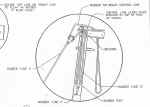
|
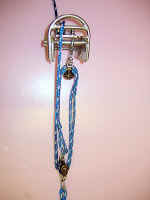
|
Left: Downhaul diagram
from Hunter H260 |
4:1
Micro block Downhaul
Harken #226 & #227
West
Marine #253294 & #253302 |
Another option is to add weight to the rudder tip. Since I have two
rudders, I added one pound of lead to one rudder to see if additional weight
helps help get it down easier. This spring I tested them both to see if
there was a difference. The unweighted rudder goes down without any problem now
because of the 4:1 purchase on the line. The weighted rudder still floats and
goes down even easier. As a result, there is no need to add weight to the
rudder.
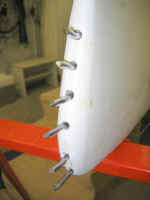 |
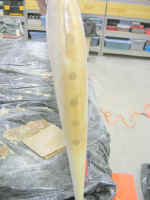
|
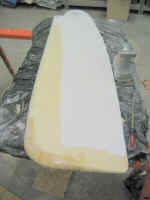
|
|
Drilled
holes, filled with resin/lead weight, glassed & painted |
Shear Pin
or No?
The H260 has a redesigned rudder and rudder housing that includes a shear
pin. It serves to make sure the rudder stays down at the correct angle but
releases when you hit something (and you will). The problem with the shear pin is that it requires some flexibility and
balance to pin the rudder. See picture of me doing the "One - Footed Flamingo Tango"
above.
Some owners have installed the CL257 Auto-Release Racing Mini cleat which
provides a neat solution to the problem of how to lock-down a rudder yet allow
it to flip-up if it hits the bottom or a solid obstacle in the water. The cleat
holds ropes from 4mm to 6mm securely yet will release them immediately when the
cleat is overloaded. The CL257 is fitted with an adjustable cam so that the
release tension can be set to suit the boat and local conditions. The cam is
adjusted until the rudder blade is held down reliably under maximum sailing
conditions. The CL257 will then be set so that the least strain is put on the
rudder if it hits something solid.
Picture
above shows installation of the CL257. For more info on the CL257 check the Camcleat
website. I purchased my CL257 from Duckworks.com
on-line store for $21.00. Also available at Fisheries
Supply. At least one person has reported losing the screw that holds the cam
in place and there is an upgrade to deal with this problem. I have not had a
problem but I ordered the $5.00 upgrade as a precaution.
Conclusion:
After tweaking the rudder and downhaul and adding the
CL257 clamcleat I'm very satisfied with the whole setup and seldom give it a
thought. I always store the rudder out of the water and every winter I repair
any damage such as cracks and scrapes. That way I improve my chances of having a
trouble-free season.
Rudder Downhaul Line
I always carry a spare rudder on trips. After a season of
hard use it usually needs some repair and replacement. I once dropped it on the
ramp and compromised the thin fiberglass shell. Another time I hit a log and had
to do the swap while the boat was in the water. I found it a pain to swap
rudders because rigging the downhaul line in the rudder was awkward -- it was
almost impossible to undo the knot and the rope was just too large to fit in the
hole easily. Now it's a simple 15min. job. Slide out the pivot bolt,
unsnap the line and replace in about 15 minutes. Cost $7.50 and no cussing. Note
how I also swapped out the downhaul line and replaced it with a swaged cable.
While you are doing this you might as well install the micro blocks and the
CL257. All three of these elements work together well.
The $10 Emergency Rudder
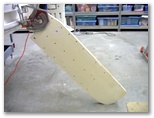
Click on the picture
|
Losing a rudder on the H260 is really not a big
deal if you have a spare. It takes only a few minutes to slap a new one on.
Without a spare, it spells the end of your
sailing day or maybe a weekend cruise, but the real problem is the long trip home.
Without a rudder you can only go about 2mph under power because the H260 yaws
from side to side as soon as you try to go faster than that.
I wanted to see if I could make an emergency rudder out of cheap materials that
was easy to install and would get me home in short order.
I'm confident the result is plenty strong.
I made both a 48" and a 36" version. I'm confident you could sail with
the longer version but not sure how the shorter one will perform. The advantage
of the shorter version is that it is lighter and easier to stow. I could refine
this design but for now I just want to see how well each version performs. As soon as the ice melts I'll try them both out
and report back.
Other
useful info on the rudder: The H26 rudder: http://www.ayesail.net/sailing/images/rudder1.jpg
(An older version of the H26 rudder but I think the concepts
are still valid)